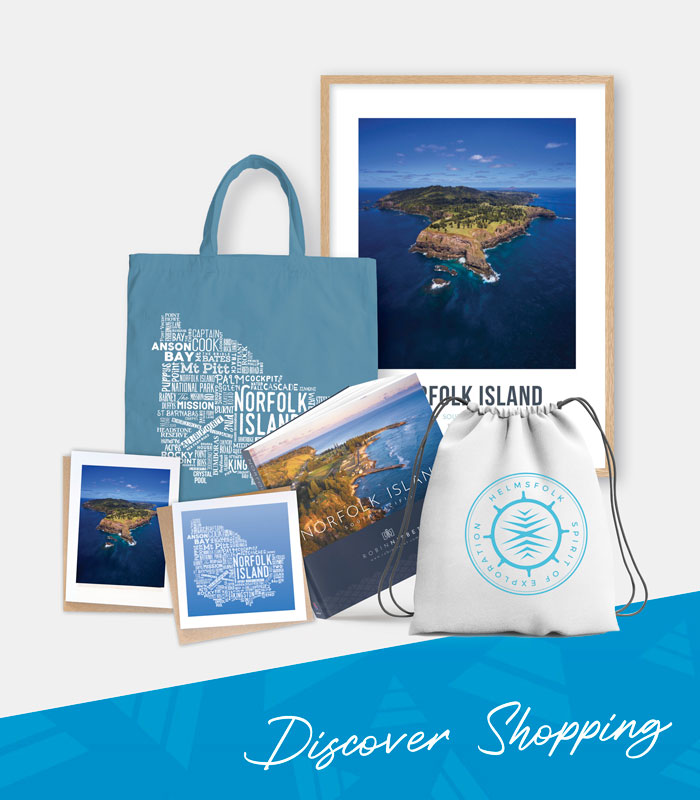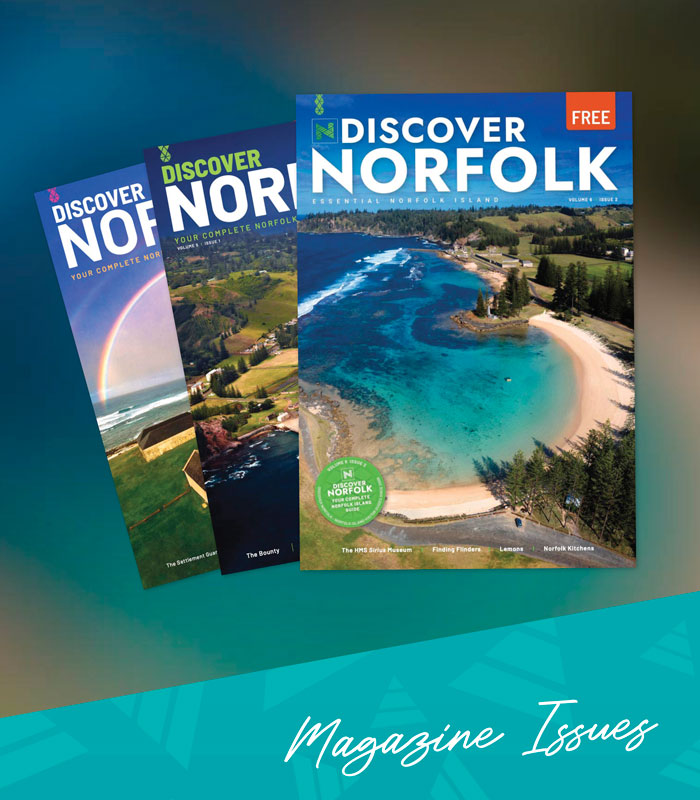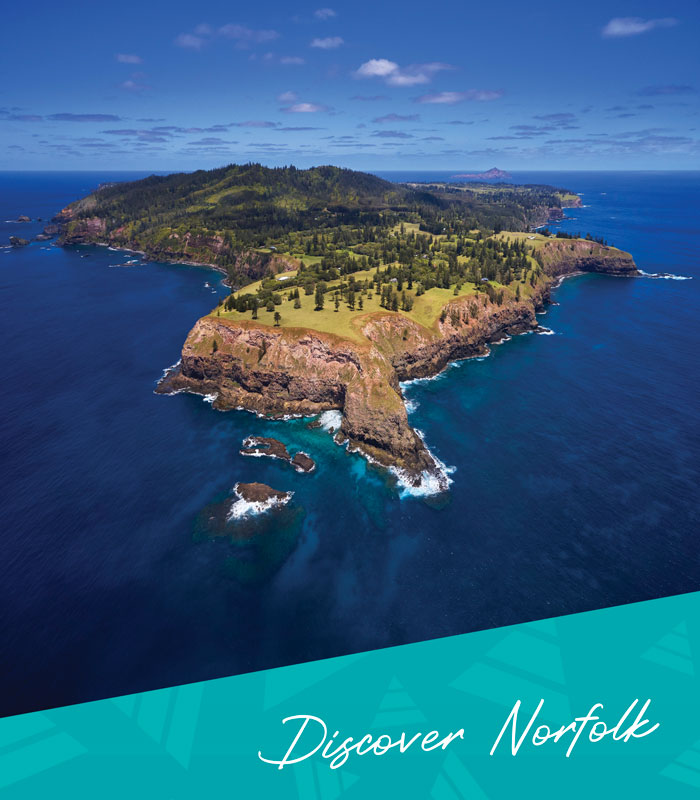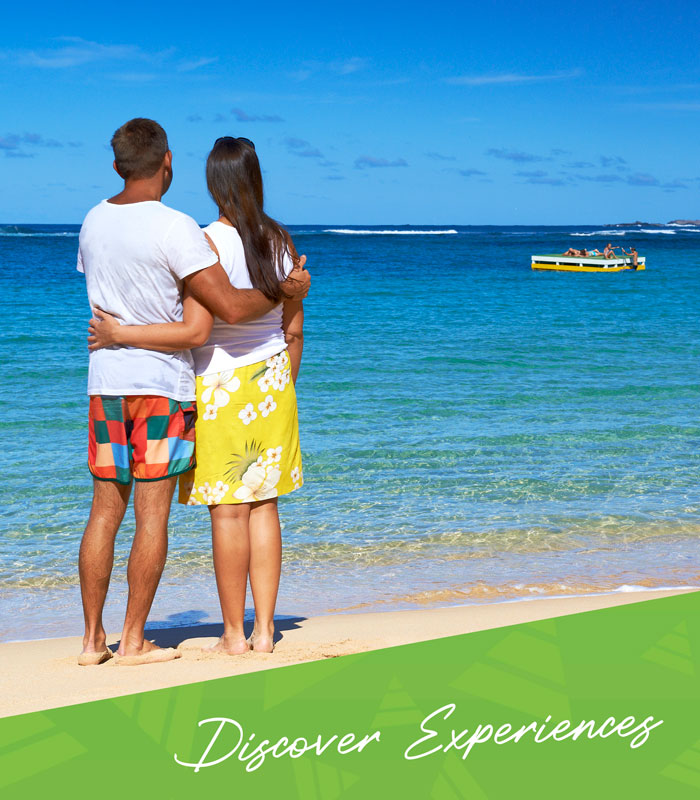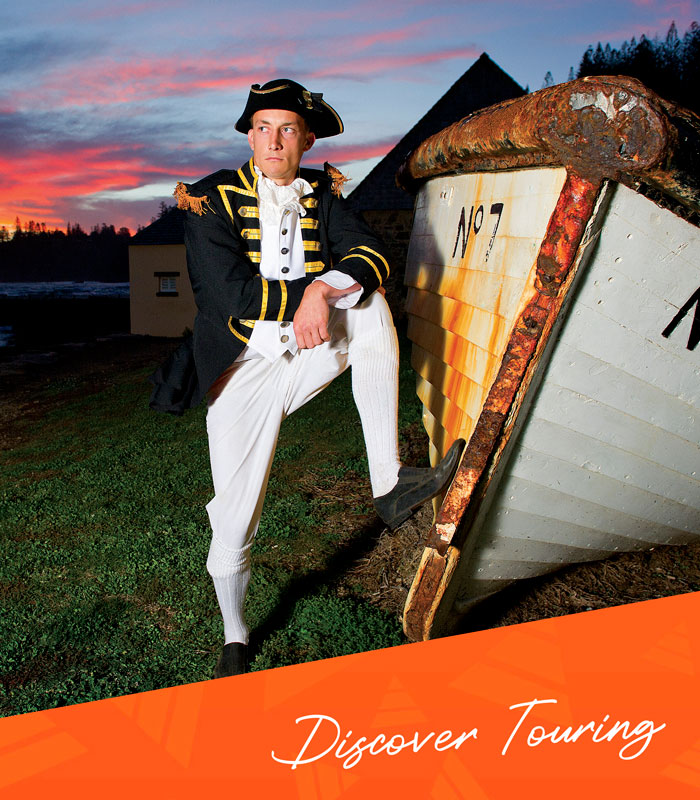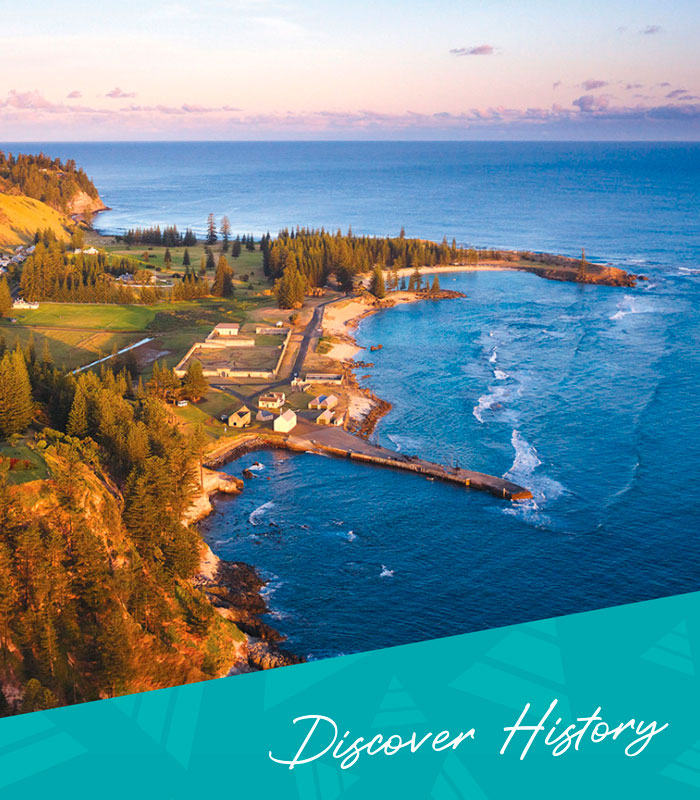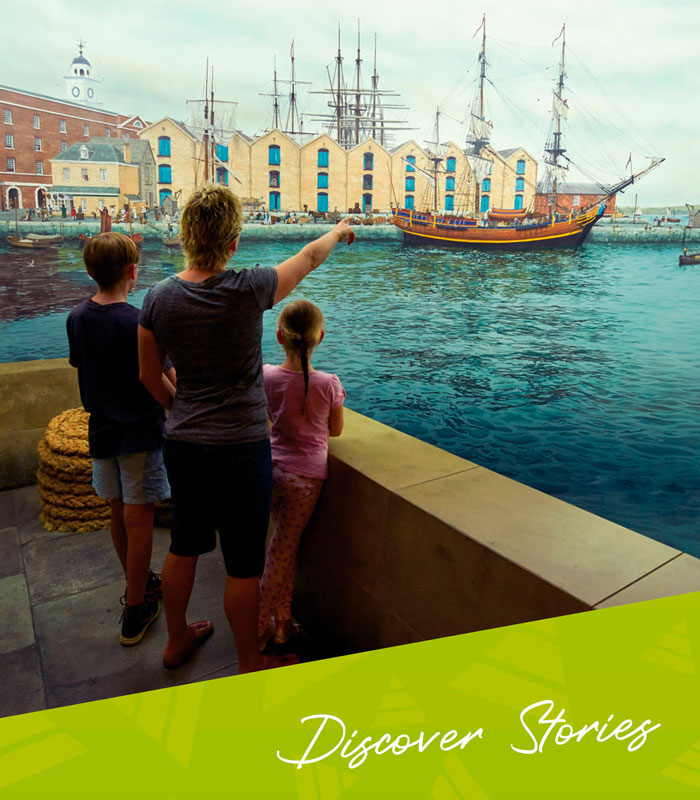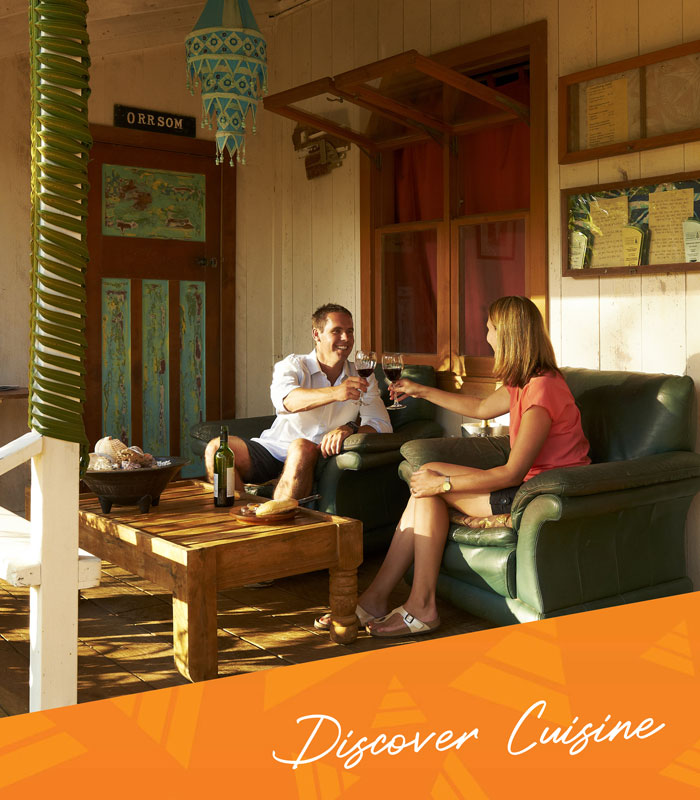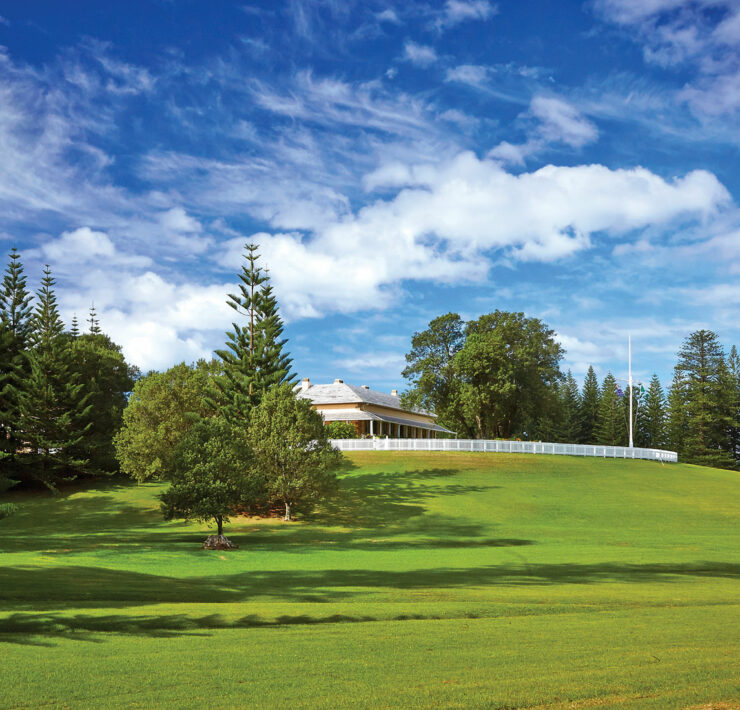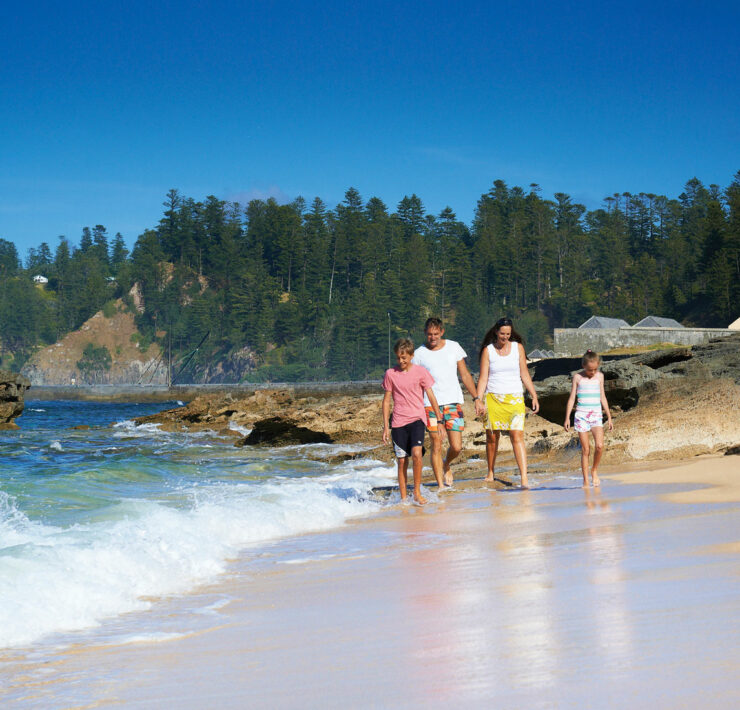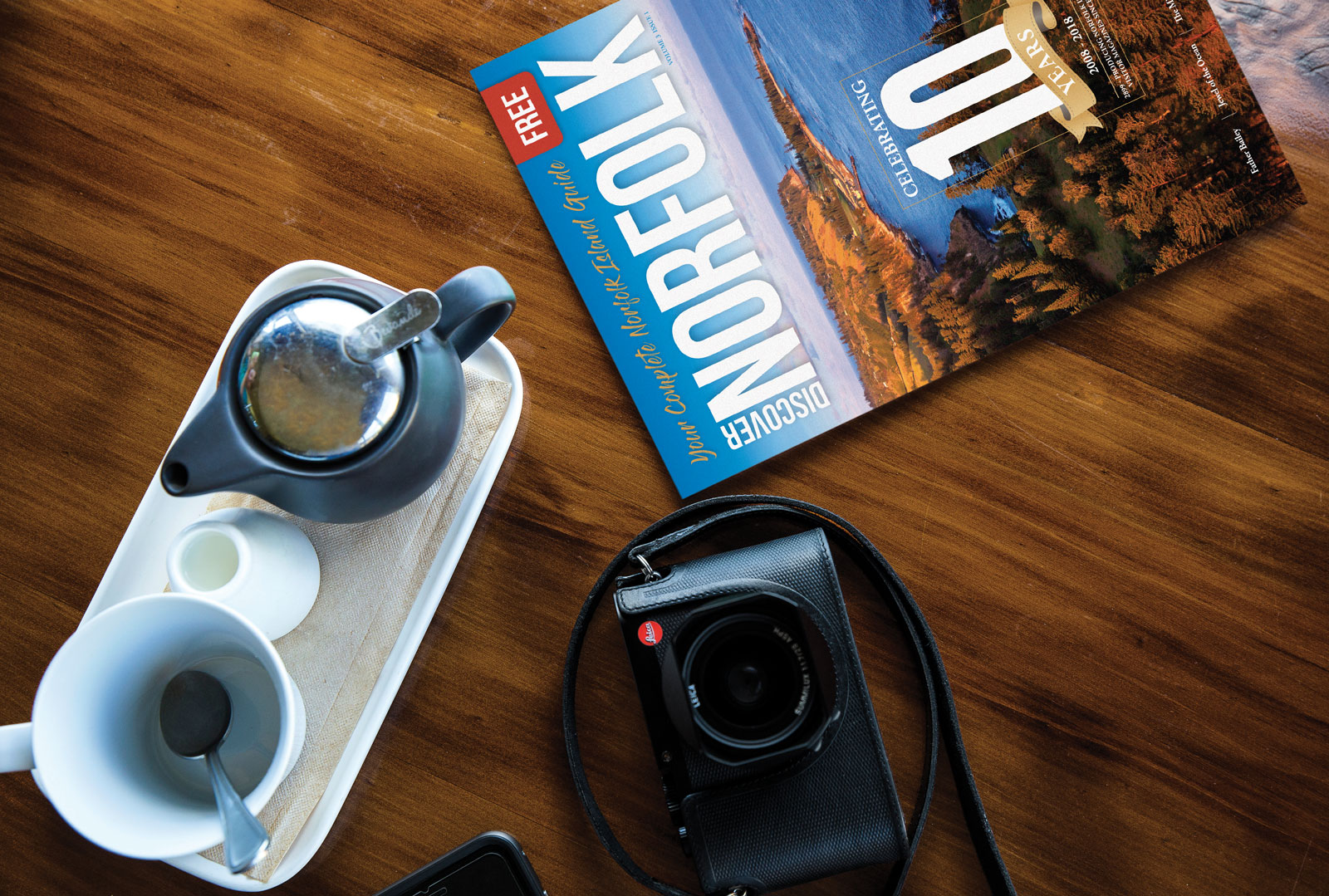Home » All Articles » Jewel of the Ocean: Celebrating 10 years of Norfolk Magazines
Jewel of the Ocean: Celebrating 10 years of Norfolk Magazines

Most people come to Norfolk by plane. A few yachts, cargo and cruise ships still sail across the wild seas to anchor just off the craggy coast, but air travel is now the quickest and easiest way to arrive. As you descend the Island appears quite suddenly; a vivid green dot in an expanse of endless ocean. It is remote, pristine and breathtakingly beautiful; visitors immediately fall ‘under its spell’.
It’s a common experience; newcomers feel at home and yield to Norfolk’s magic. They’re enchanted by its quaint friendliness and want to tell everyone about it – so they write stories, compose songs, take photos or paint pictures. Over the years many authors and artists, including Colleen McCullough, Ruth Park and Kasey Chambers, have been inspired by this fascinating Pacific gem. They have enjoyed living on the Island and sought to explain its allure.
The Norfolk pines (Araucaria heterophylla) – ancient conifers endemic to this tiny, volcanic isle – have seen voyagers, explorers and pioneers wash up on these shores. Mighty forest giants, covered in moss and ferns, and the lone pine, standing like a sentinel at Point Hunter, have witnessed the ebb and flow of human migration on Norfolk Island for centuries – wanderers have sheltered here, and then moved on.
Over 600 years ago Polynesian seafarers, traversing the vast Pacific in canoes – and navigating by the stars – came to Norfolk. They didn’t stay long; leaving only scattered remnants to mark their passing. Captain James Cook and his men landed in 1774, made their reports, and also sailed away. Fourteen years later convicts and guards arrived, and tried to use the pines and flax as masts and sails for the British navy. The plan failed and, after a couple of decades, the whole colony was abandoned.
The Island lay uninhabited until a second settlement, designed to be a ‘hell on earth’ for Britain’s worst felons, was founded. For thirty years it was a place of savage punishment, brutality and exile; ruled by Commandants who, in the main, had little sympathy for their charges. Finally, in 1855, changing attitudes towards transportation and gaols ended this cruel chapter; the prison closed, and the gibbet, lash and infamous dumb cells were forsaken.
Then, in 1856, Norfolk became home to the descendants of the Bounty mutineers. They had outgrown Pitcairn Island, and journeyed more than 6000 km to forge a new society. Farming and whaling sustained them into the twentieth century, but the building of an airstrip during World War II encouraged large-scale tourism. Gradually, the industry developed and Islanders welcomed visitors, and new residents, from Australia, New Zealand and other countries.
Robin Nisbet – a photographer and graphic designer from Scotland – first came to Norfolk with his wife, a local girl, in 2000. Captivated by its beauty, and amazing charm, Robin dreamt of producing a high-quality magazine that would showcase the Island’s history, scenery, people and businesses in an informative and visually appealing way. He wanted to provide interesting articles and evocative photography – in a readily accessible format – to travellers and Islanders, and believed this would help promote Norfolk to the wider world.
The first issue appeared in December 2008, and was an immediate success. An array of features and gorgeous photographs endorsed Norfolk as a ‘must-see’ destination, while sensitively exploring its heritage and culture. Over the following years Robin distilled a formula which has allowed him to oversee and edit twenty-six deluxe Visitor Guides; presenting a wealth of memorable stories and images about this ‘jewel of the ocean’. The Discover Norfolk website: www.norfolkisland.net has a complete archive of every edition and it’s a treasure trove for anyone wanting to know more about this place.
Robin’s very first Editorial summed up his feelings, “As a photographer and designer, I continually strive to convey Norfolk Island’s wonderful and unique patchwork of colours, textures, places, events, ideas, experiences and emotions into one visual landscape. This is not easy. Norfolk Island doesn’t have an Eiffel Tower, a Golden Gate Bridge or, for that matter, an Edinburgh Castle, but it does have something equally emotive, rich and beautiful; just not so iconic and easy to impart.”
Looking through a decade’s worth of magazines – filled with articles on whaling, weaving and everything in between – it’s clear they’ve made an invaluable contribution to Norfolk’s tourism industry, and documented island-life, and traditions, for future generations. Robin has also encouraged locals to write passionately about their home and its remarkable history. So, is it possible to completely explain why Islanders, residents and guests love Norfolk? What is its secret? The glossy advertising brochures say, “There’s more to Norfolk Island”, and this is true – it’s a place, I believe, of refuge, safety and freedom. It’s a haven for those seeking to escape the ‘rat race’.
This idea of living in an enclosed space; a world unto itself, can best be understood if you wander along Norfolk’s rugged coastline. Looking beyond Kingston pier, the cliffs – clad in tall pines and greenery – rise sharply from the swelling water. Sea haze rolls in, and weak afternoon sun sifts through patchy clouds, as white-capped breakers pound the basalt headlands with a rush of noise and salt spray. Novelist Ruth Park described Norfolk as like “…a ship, all alone in the ocean, secure, well-found, never sunk yet, and its pines were ten thousand masts.” Time appears to stand still as beach grasses flatten before the wind and waves crash relentlessly against rocks and stony outcrops.
There is the possibility, too, of leading a less stressful existence. Norfolk is not untouched by global problems and concerns, but political scandals, terrorism and war zones seem reassuringly far away. Despite its size – only 8 by 5 km – there’s a great feeling of space and privacy, and a sense of wonder as you explore the sub-tropical forest. Mt Pitt and Mt Bates rise steeply in the north-west and, when walking or driving carefully on the winding roads, plunging down into gullies, and up steep hills, spectacular views greet you at every turn.
In the morning I look out on my valley, quietly sip a ‘cuppa’, and prepare for the day ahead. Rain or shine, like the captain of a ship, I gaze upon a sea of lush, green grass lapping the shore of my ‘randa (porch). Beyond this side (place) lies a tapestry of bushes, palms, pines and towering tree-ferns. Cottages and buildings cluster on the opposite ridge and, farther away, the ocean glints and whispers enticingly.
I never tire of this view – the light and colours are mesmerising – fresh air fills my lungs and the gentle sound of bird song surrounds me. Sometimes a buzzing lawnmower, the drone of cars or a forlorn cow’s bellow, disturbs my reverie, but the feeling of serenity remains. On bright mornings I linger over coffee, limbs warmed by the sun, and watch butterflies dip and flutter in the golden light. Chooks and proud roosters wander by; pecking and scratching intently amid the leaf litter, pumpkin vines and compost heap.
In the late afternoon I sit and enjoy the scene once more. Sounds echo across the valley: laughter, music, dogs barking and tinkling wind chimes. The faint whine of a model aeroplane filters through the hedge; another day is ending and there’s time for solitude. Darkness descends and everything changes; white stars glitter in the blue-black sky and shadowy trees are silhouetted against the horizon. The telescope lets me see remote suns and planets, blazing brightly in the inky heavens, but the night is cool, quiet and peaceful.
When Robin founded the magazines he wrote, “…Although I will never be a Norfolk Islander it does not affect my sense of belonging to this ‘paradise’ in the South Pacific.” I know what he means – I’m a relative newcomer, but it’s not long before you feel comfortable and at home here. The pace of life is slower; people stop and say ‘Hello’ and it’s possible to forget your worries and be immersed in nature. A small, friendly population also means that we trust, and genuinely care about our neighbours. We’re interested in what they say – their anecdotes and stories – and we want to share their tales with visitors and travellers.
On Norfolk you can express yourself, and also be part of a close-knit community. Robin noted, “While shooting images to accompany articles I found myself invited and welcomed in a way I hadn’t experienced before. Whether in a lighter boat, in someone’s kitchen, or holding a camera in front of someone I’d barely met, I felt an acceptance, and a confidence that I would capture, and relate what I saw, to the best of my ability.” That is something he still feels today. A mutal respect for Norfolk Island and its people has always been a core value of the publication. Locals placed their faith in Robin, and were happy to share their stories with him, and believed he would portray them honestly.
So, as we celebrate ten years of these magazines, and consider the stunning imagery and marvellous features highlighted within their pages, it’s worth remembering that Norfolk still lets you escape to a simpler, more laid-back world. As you roam around, exploring hidden pathways, convict ruins and the old cemetery which sleeps by the sea, you’ll sense echoes of the past and hear the wind murmuring through the pines. Norfolk Island – “…you’re something to see, I’d give you my heart but you already stole it from me.”
____
Image Credit: Robin Nisbet
www.robinnisbet.com
____
Article content disclaimer: Article first published in Discover Norfolk, Volume 03 Issue 01, 2019. Please note that details of specific travel, accommodation and touring options may be outdated. References to people, places and businesses, including operating days and times may be have changed. References to Government structure and Government businesses/entities may no longer be applicable. Please check directly with businesses and/or Government websites directly rather than relying on any information contained in this article before you make travel arrangements.


